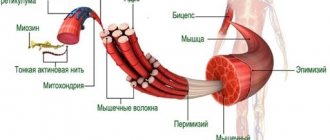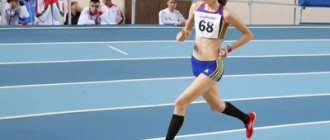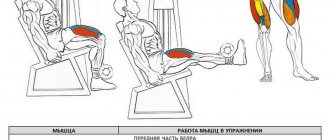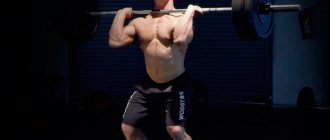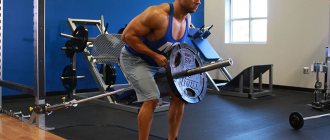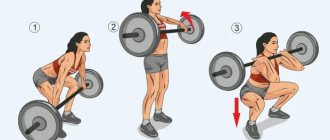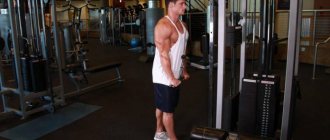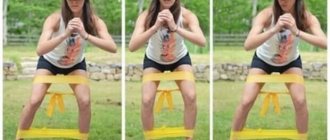Hello my dear readers!
To understand how to speed up running, you need to find out what it depends on, what method of speed running. There are special exercises that develop speed. Let's talk about everything in order.
Running speed is determined by natural reasons that cannot be changed. But with constant effort, you can improve your execution and unlock your potential.
The speed of movement depends on nervous processes that affect:
- the ability of muscles to quickly contract and relax;
- the ability of a person to make a large number of movements in a short time.
If a person is tense and all his muscles are too, he cannot run fast. It is very important to learn to move in a relaxed state, otherwise it will be impossible to cover a long distance. In addition, you can stretch the ligaments.
Excitatory and inhibitory processes occur in the human head, and the goal of training to increase running speed is to influence the inhibitory effect of antagonist muscles.
In addition to the reasons inherent in human nature, the ability to cover distances at speed is influenced by the following components:
- internal state;
- nervous and physical overload;
- psychological condition;
- external reasons (weather, clothing).
Running speed is determined by stride length and frequency, so during training you need to focus on working on these components.
Speed running technique
When asked the question of how to increase running speed, special attention is always paid to running technique. Regardless of the level of physical fitness, the number of classes or strengths, or working without equipment, the speed will not be higher.
A technical runner with a less developed muscular system will be able to arrive earlier than a muscular runner with a left-handed running technique. Of course, the lack of proper technology will not allow you to fully realize your physical abilities.
It is important to understand that the technique of running at high speed is significantly different from others.
A person who wants to run fast is probably familiar with the peculiarities of high-speed running techniques. First of all, this is a reduction in the flight phase. When running at speed, you should emphasize strong pressure.
Considering that the athlete develops high speeds when running short distances, he can run at his peak the whole way. This will allow you to make more massive jumps and breaks. This will significantly increase running speed if he is running on his heels.
Cadence is the number of steps a runner takes in a minute. Running speed at high speeds should also be higher. The flight phase should be reduced due to the rapid increase in leg speed, but in no case due to a shortening of this phase.
Otherwise, efficiency will decrease. To develop the correct technique, you must perform specific exercises. Many high-speed running technologies have been developed. The main thing is to choose the right ones and fit them into your plan.
A standard set of specific running exercises should be performed before high-speed running, as well as after cross-training.
Slow and fast muscle fibers
Based on the speed of contraction, a distinction is made between “slow twitch” or slow (ST from English slow twitch) and “fast twitch” or fast (FT from English fast twitch) muscle fibers.
Slow or ST fibers
Thin, relatively weak, but at the same time resistant to fatigue. They are well supplied with blood and have a higher amount of myoglobin, which gives them their characteristic red color (red fibers). ST fibers contain many mitochondria and are characterized by high levels of aerobic enzyme activity. The amount of ATPase enzyme is small, which causes the low rate of contraction. Slow fibers are most adapted to static or prolonged monotonous loads of low intensity: maintaining a pose, light running.
Fast or FT fibers
Fast-twitch fibers are thicker than ST fibers and produce more force but also fatigue more quickly. These fibers are less perfused and have less mitochondria, lipids, and myoglobin than ST fibers (described as white fibers). Unlike slow fibers, fast fibers contain mainly enzymes for anaerobic glucose oxidation (glycolysis). Glycogen (carbohydrates) and creatine reserves are used as the main sources of energy. Due to their high contraction speed and rapid fatigue, these fibers are capable of short-term and high-intensity work: fast running, 100m sprint, for example.
Fast fibers can be divided into two subtypes. Their difference is in the method of obtaining energy: the first ( subtype A ) can use oxygen to obtain energy by oxidizing carbohydrates and fats, the second ( subtype B ) practically do not use oxygen.
The predominance of FT or ST muscle fibers will largely determine the speed potential of the athlete. If there are more fast myofibrils in the body, you can achieve high results in short-distance running, as well as in sprint swimming, weightlifting, martial arts and other sports disciplines, where the impulse, explosive work that FT provides is primarily important. muscle fibers. If slow-twitch muscle fibers predominate, there will be much more prospects in long-distance running, as well as: in long-distance swimming, road cycling, cross-country skiing, rowing, triathlon, etc., that is, in those sports where aerobic activity plays a major role. energy generation system.
In most people, the ratio of different types of myofibrils in muscles is approximately the same: 50 to 50%. But this is no reason to despair. Firstly, you can try to develop in sprinting or long-distance running, gradually adapting your muscles and your body through training. And secondly, middle-distance running, cross-country, as well as middle-distance swimming, many team sports (football, basketball, etc.) and even... chess are well suited. After all, this will have much more health benefits than TV, social networks or complaining about bad heredity.
Elite sprinters can have up to 80% fast myofibers in their muscles, while marathon runners, on the contrary, have up to 80% slow ones. But potential is only a more favorable starting position. Without training, he remains a potential!
Features of training
The result of increasing running speed will not last long if the following are completed:
- There is a specific goal (overcoming a distance in a certain time).
- Constant courses with full dedication.
- There is a training program.
Leg muscles are important for running speed. Therefore, you should include leg strength exercises in your course.
The second point is jumping, the ability to push and accelerate when jumping. It is necessary to perform not only static, but also dynamic exercises.
To feel the speed, you must accelerate, for example, 60 - 150 m to the finish line. Many coaches advise not to forget to include speed, jumping and strength exercises in your training, as well as to practice your running technique by performing SBU.
Muscles and heredity
There are about 600 muscles in the human body, most of which are used during running. Skeletal muscle itself is a bundle of thin longitudinal fibers - myofibrils, which include the contractile proteins actin and myosin, which provide movement. Myofibrils come in several types, the ratio of which in the muscle is determined by heredity. To a large extent, a person’s speed performance and his “prospects” not only in running, but also in other sports will depend on this ratio.
Techniques for increasing speed
To increase your running speed, you need to develop skills that help you achieve your goal. Such techniques are included in training programs and are often performed during training.
A common example is alternating running, which allows you to develop resistance (speed). The exercise is performed on a treadmill, in a stadium or park. Distance - at least 50 meters. You should run very quickly, then start jogging and return to the starting point. Returning to the beginning, without stopping, run again and also come back. It is enough to do 5-10 repetitions.
Variable running (or range) can be performed over medium distances. For example, if you run for a minute at a slow or medium pace, it will speed up by 10-20 seconds. Slow down and run for a few minutes at a moderate pace. Such a run is called torn.
The main methods for increasing running speed are revealed.
These are: the study of individual parts of the technology and their development, as well as the high-speed resistance technique.
Maximum oxygen consumption
The role of muscles in ensuring speed qualities is great, but, of course, not absolute. After all, in order for muscles, as well as other vital organs, to receive oxygen, the coordinated work of the respiratory and cardiovascular systems is necessary.
The most well-known indicator describing the connection and efficiency of these systems and muscles is maximum oxygen consumption (VO2 max), which shows the amount of oxygen (in milliliters) that a person is able to consume within 1 minute.
On average, MOC in young untrained men is 45 ml/min/kg, in women – 38 ml/min/kg.
As a result of training, not only does the number of mitochondria in the muscles increase, but also physiological adaptations occur such as an increase in blood plasma volume, systolic heart volume and stroke volume, tissue capillarization and, ultimately, such adaptations cause an improvement in the efficiency of oxygen transport to muscle cells and its use, and this is the key to improving performance in medium and long distance races.
MOC depends on genetic factors, age, gender, and is also closely related to muscle mass and quite accurately reflects the level of training.
Up to 20 years of age, the MIC value increases, from 25 to 35 years of age there is stabilization, and from 35 years of age there is a gradual decrease in MIC.
By age 65, maximum oxygen consumption decreases by about a third.
Exercises to develop running speed
Gorki
Slides are a universal exercise for increasing endurance, strength and to increase running speed. In addition to strengthening your muscles, downhill running also develops your cardiovascular system and oxygen absorption efficiency. This means that a person can run faster this way.
Important points:
- starts with running on low hills, with a slight incline and short distances (50-60 m.)
- after the hills, run and “extend” the legs, that is, several accelerations
- do 1-2 times a week, depending on the volume of training and tasks
Special running exercises
Special Running Exercises (SBE) are high-speed exercises that affect the efficiency of movements while running. And the more economical the running, the higher the speed.
These are the muscles of the front and back of the leg, the flexor muscles, the knee joint, the leg muscles, the flexor muscles of the leg and lower leg, which create repulsion, and the muscles responsible for the hips.
In addition, SBU helps improve muscle coordination.
Regarding exercises:
Running with shin splints
The exercises are mainly aimed at warming up the knee joint and strengthening the muscles of the back of the leg.
Technique:
- In this exercise, you perform a flexible run with the legs bent at the knee joint and the legs kicked towards the buttocks. In this case, reaching the buttocks with the heel and a high cadence are fundamental.
- During the exercises, the body is slightly tilted forward, the shoulders are relaxed, and the arms work in the same way as when running (or simply backward). While performing the exercise, pay attention to the gentle removal of the foot from the support.
- Running with high hips
Exercise targets the anterior muscles and leg flexors and helps improve muscle coordination.
Technique:
- While standing on your feet, you should alternately raise your legs. The foot rises parallel to the surface, and upon landing it is flexibly placed on the support. It is necessary to maintain a high frequency of leg lifts.
- During this exercise, your shoulders should be relaxed, your elbows bent, your supporting leg and body should be in line. The foot lands in front, the back should be straight. Beginners can work with their hands, experienced runners can work with their hands behind their backs.
- Running on straight legs
Exercise affects the muscles of the legs, as well as the muscles responsible for the hips. Helps improve repulsion.
Technique:
When performing the exercise, the straight leg is adjacent to the support, and the support of the second leg is at an angle of 45 °.
- The body is straight, with a slight slope of the back. Hands as if running.
- Deer running
The exercise is aimed at developing the muscles of the legs and back of the legs.
Technique:
- When bending, the severed leg is fully straightened, and the support leg is extended forward, bending at the knee joint. The arms work to help maintain balance.
- The body position is vertical with a slight bend forward.
- "Bike"
This exercise helps strengthen the hamstrings and flexor muscles, as well as the legs themselves.
Technique:
- The leg is bent at the knee joint, the foot is raised parallel to the ground. Next, the lower leg moves forward, and the legs begin to fall onto the support under the center of gravity. After the push, the leg is thrown back, and the movement is repeated, but with the other leg.
- The body is in an upright position. Hands make active movements with greater amplitude.
- Lunges
Lunges develop balance, endurance and coordination
Technique:
- The exercise is slow. The stride should be of such length that the angle of the front leg is correct.
- Very wide heel steps while squatting deep. If done correctly over the next two days, all the muscles in your legs will hurt.
- Mincing run
The exercise develops running technique and coordination.
- Short steps along the length of the leg. Squats on your toes, shoulders and arms relaxed.
- SBU can be practiced without the help of other people at home, but it is useful to first determine the technique of the exercises.
Segments
Line segments are specific and operate at speed. Depending on the goals and objectives, the rolling intensity and length of the segments will vary.
What is important:
- 200-300 m will be enough
- For those who like speed work, recovery after stretching is suitable - rest (running for about 8 minutes)
- to begin with, the number of segments will be 3-5, the main thing is acceleration
- It is best to do calm speed work and “be fresh”, for example on Tuesdays, after the weekend on Monday or even on Wednesday
- when you work with trained athletes who have experience and an excellent base, the number of segments and length can be increased depending on the tasks.
— Dima, please tell me, will running exercises for long and medium distances be different, and how?
- At the initial stages - not really. Later, of course, for middle-distance runners, along with developing speed, it will be necessary for the body to adapt to use lactate to operate in an “acidification” mode. For long-distance runners, the metabolism will create a fat oxidation system that is achieved during long runs in the aerobic zone.
— How about introducing marathon courses for long-distance runners?
- This is unlikely to be necessary for the majority. Of course, everything will depend on the goals and objectives of the training. For some, this look will be relevant. But due to the stress on the cardiovascular system, it must be used wisely.
It is not for nothing that in all athletics training systems there will necessarily be a long and slow run. Arthur Lydiard was the popularizer of such running in the practice of training athletes. In particular, long, slow running helps develop the cardiovascular system for the stress of high-speed work.
- How about introducing a running exercise called fartlek (variable speed running) to improve your running speed?
- Fartlek is also a very good method when used correctly. For example, by mixing acceleration with jogging, fartlek can be used to develop high-speed skills. Long accelerations and fast runs to develop speed endurance.
- But in general everything must be taken into account.
There is a popular saying among athletes: “A plan is not a dogma, but a guide to action.”
By the way, as it turned out, this was reformulated from an article by Engels and Marx.
— Of course, thank you, Dima!
- With pleasure! And don’t forget about the importance of quality recovery after the course. Otherwise, the results may be reduced to zero. There will be excellent basic training - the speed will come! Practice often and don't rush! Remember - you are here to improve your health!
Can the number and ratio of ST and FT fibers in the body change?
The data is not yet final. Some studies show that the ratio of ST and FT myofibrils does not change as a result of training and is completely determined by genetics. Other studies show that aerobic training increases the content of slow myofibers. True, such changes are very limited and do not exceed 10%.
At the same time, during training, the number of mitochondria in the muscles can change, and, accordingly, their ability to generate energy with the participation of oxygen. It is also important for speed, especially over long distances. In addition, training leads to muscle fiber hypertrophy and the percentage of muscles will also change.
In untrained people, fast fibers are usually glycolytic, that is, type B predominates, and slow fibers are oxidative. This will be enough for mini-sprint races of 20-30 m to the bus stop or, for example, to the entrance from the meeting with the neighbor's dog. But of course, it is absolutely not enough for competitive sprinting and, especially, fast running over medium and long distances. There is no way without targeted training.
Mitochondria are unique organelles in which glucose or fatty acid molecules are broken down through a cascade of reactions into carbon dioxide and water, resynthesizing ATP necessary for muscle contraction. At the same time, it does not form lactic acid molecules, which “acidify” the muscle, as during glycolysis. Due to the appearance of additional mitochondria, fast muscle fibers in their oxidative potential are converted from glycolytic to intermediate, and the transition of intermediate fibers to oxidative is also possible.
Even if your genetics don’t work out, by training regularly you can significantly improve your performance and achieve good and sometimes excellent results!
How to increase running speed over medium and long distances
This article will talk about how to increase your average speed over medium and long distances. This means that some of the events need to be structured so that the pace of the run itself is faster than the pace at which you walk over distances.
Take for example 1000 meters. If you need to cover this distance in 3 minutes, then run at a speed of 2 minutes and 50 seconds. But not the whole kilometer, but segments.
Specifically, you should be doing intervals between 200-400-600m, at a faster speed than you would run a 1km race or competition.
The same goes for other distances.
For example, 10 times, 200 meters each with a 2-3 minute break, or a 200-meter run. And 200 meters at a speed exceeding average.
If you want to walk a kilometer in 3 minutes 20 seconds, this means that you must cover a distance of 200 meters in 40 seconds. When you're working on segments with rest in between, run the 200 for 37-38 seconds.
The same is true for other distances. If you're training for a 10K run and want to run under 40 minutes, then work in 1K intervals at 3m 50sec per kilometer. Between segments, rest for 2 minutes or lightly roll for 200-400 meters.
It will be easier for you to overcome because the body has a range of speeds.
Train your endurance
If you need to run 3 km, then in order for the body to withstand running for that distance, you need a reserve of resistance. You need to run 6-10 km. Because of this, the body will be ready to work within 10 or 12 minutes, as it is used to running long distances.
This rule also applies to longer segments.
For example, if you need to show excellent running in a half marathon or marathon, then, of course, you will not be able to run 40-50 km without stopping and have a reserve of endurance.
This is developed by 2 classes a day or daily classes. That is, for example, you conducted daytime classes in segments where you ran 10 times, 1000 meters each. In the evening, do a 10km roundabout at a slow pace.
For this reason, the total mileage will be more than 20 km.
Professional marathon runners cover 1000 km per month using only the law of endurance. Amateurs cannot handle this volume.
Since the body is not fully restored after previous work and a new task has already been received. I repeat, not completely, this does not mean that it was not partially restored.
If you run as fast as possible, you will only harm your body and future performance.
Types (Forms) of speed
Happy shopping on iHerb!
Speed has different types of manifestation. Speed is distinguished as the ability for quick motor reactions to a visual, sound or tactile stimulus.
For example, the speed of a fencer’s reaction in response to an opponent’s action, the speed of movement from the start of a short-distance runner.
Speed is also expressed in the ability to change movements in direction and character, and to stop movements. This is the side of the quality of speed that is most manifested in sports games, downhill skiing, and slalom.
The main types of manifestation of human speed:
- motor reaction time,
- time to perform a single movement as quickly as possible,
- time of movement with maximum frequency,
- time for performing a complete motor act.
There is also another type of manifestation of speed (“speed qualities”) - the rapid start of movement (what is called “sharpness” in sports practice).
In practice, the speed of integral motor acts (running, swimming, etc.) is of greatest importance, and not the elementary types of manifestation of speed, although the speed of integral movement only indirectly characterizes the speed of a person.
One of the characteristics of speed is the frequency of movements, which plays a big role in such actions as, for example, sprinting, operating a radio transmitter key, playing a trill on a musical instrument, etc.
Speed is manifested in the ability to repeat movements frequently; for example, the movements of a basketball player dribbling a ball, the movements of a sprinter.
The smaller the mass of the moving part of the body, the higher the frequency it can develop. The highest frequency of movements is that of the fingers and hand as a whole. The slowest movements in the wrist, elbow and shoulder joints are those of the torso. The speed of movement frequency develops very little.
To develop the frequency of movements, you can use running in place with a maximum, naturally, frequency, but with minimal lifting of the feet from the floor. This exercise can also be used as a corresponding test, counting the number of steps in 10 seconds. (it’s more convenient to count touches of the floor with any foot).
In order to exceed the maximum speed and frequency of movements, you can use a sound rhythm or appropriate music. To musical accompaniment with a distinct accelerating rhythm, designed for 15-30 seconds. movement, it is much easier to show maximum speed and try to exceed it.
Thus, in an experiment, running in place to an accelerating dance rhythm allowed athletes to increase the frequency of movements by 5-8%.
Speed is also manifested in the ability to cover a certain distance in the shortest period of time, as well as impulsiveness, the sharpness of single or repeated movements. There is a connection between the indicated forms of manifestation of speed, but there is no direct dependence.
Content
- 1 Speed training 1.1 Types of speed
- 1.2 Is speed a factor of coordination or general physical fitness?
- 2.1 Anatomical and muscular-physiological factors
- 3.1 Methods for training simple and complex reaction speed
Losing excess weight
Losing a few pounds can cut your running speed by 20 seconds. But with active training and preparation for competitions, it is quite difficult to lose weight, because the body needs energy and you should not severely limit your diet. We recommend that you use the following recommendations when preparing your diet:
- Eliminate empty calorie foods. Sugary sodas, candy, fried snacks, and sugar-laden baked goods contain calories that are not good sources of nutrition.
- Eat foods rich in nutrients: vegetables, fruits and berries
- Choose meals based on lean protein, whole grains and leafy greens.
Also watch your portion sizes. You can eat a large lunch after your workout, but never eat more calories than you burned. To create an individual nutrition schedule, consult a nutritionist who will take into account the number of calories burned while running.
Psychology of sports
Now we can move on to another important issue. Do you think such concepts as “sport” and “psychology” are compatible? Yes, and is it necessary to combine them at all? Opinions may vary, but frankly, there is a very close connection between athletic performance and psychology. It’s just a pity that they attached importance to this conclusion relatively recently. Any progress requires additional support functions. Requirements for athletes have recently increased significantly, which ultimately led to the emergence of such a young branch of science as sports psychology.
And if you say that only professional athletes need this, I dare to disagree. Since you decided to take care of yourself without being an athlete, what guided you? Is it not willpower, motivation and visualization? Willpower “forced” you to see (visualize) the future desired result, motivation “launched” the mechanism of action and here you are, searching for solutions to your needs! So, as you can see, the indicators characterizing your requests depend primarily on your psychological state and mood.
Interview with Dmitir Nikolaychuk
What exercises do athletes use in practice to develop running speed? How can amateur runners increase their running speed?
Professional athletes are best versed in matters of speed development. Dmitry Nikolaychuk shared approaches and “secrets” for learning to run fast .
- Hello, Dima! Our readers will be interested in learning about the experience of a professional athlete. Please tell us what approaches are used to develop speed among amateurs?
– It’s hard to call me a professional athlete. I would say that I am simply a professional, since my main job is scientific activity plus coaching practice, which, however, does not at all prevent me from competing at official competitions. Although after each podium at the National Championships, the club and coach tell me that it’s enough to mock others with this approach and way of life.
- So here it is. The main approach when working with amateurs is to do no harm.
